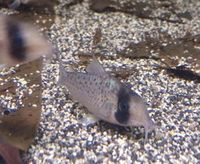Long Nosed Fairy Catfish (Corydoras sychri)
From The Aquarium Wiki
Long Nosed Fairy Catfish
Corydoras sychri
76 Litres (20 US G.)
5.1-6.6cm (2-2.6 ")
Freshwater
6.0 - 7.5
22 -26 °C (71.6-78.8°F)
5-12 °d
1:1 M:F
4-5 years
Family
Callichthyidae
| You can contribute to the Aquarium Wiki by expanding this article. Dont be shy!. |
Contents
Origin[edit]
- South America: Nanay River basin, Loreto, Peru.
Sexing[edit]
- When properly conditioned, the difference between the male and female Corydoras is usually quite evident. Females will look a lot wider when viewed from the top, as they have a larger underbelly. Males are also shorter in length than females.
Tank compatibility[edit]
- Very peaceful community fish. Will not intentionally bother tank inhabitants, however their bumbling about the tank may bother more delicate fish or other bottom dwellers. Are best kept in groups of 5-6 or more.
Diet[edit]
- As with most Corydoras, these fish will eat most food which sinks to the bottom of the tank. Sinking algae pellets should be supplemented with flake food or other sinking foods like catfish pellets.
- Be aware these fish do have a carnivorous side to them and love foods such as Bloodworm and Brine Shrimp. Vegetable-based foods offer little nutrition to them. They will also eat any dead, dying, or even injured fish, that sit on the substrate too long. They're very opportunistic!
Feeding regime[edit]
- These fish are most active at night, so feeding once before lights out is typically enough. Though they can easily be persuaded to feed during the day. Since they are slower eaters they should be allowed at least 30 minutes to consume their food.
Environment specifics[edit]
- Requires a sand or small gravel substrate and prefers a planted tank. Keeping a cory on sharp or large gravel can lead to damage to their barbels, which when infected will make it hard for the cory to find food.
- Corys are sensitive to salt, as with other scaleless fish, adding salt to the tank will cause them harm.
Behaviour[edit]
- The Corydoras group of fish frequently gulps air. This is normal and is not a cause for concern. If too little room is available between the water surface and the hood (<2") the fish may hit the hood. They hold the air in their stomach and the thin lining dissipates the oxygen.
- This fish likes the company of its own kind. It is recommended to keep at least 2, or better yet, several of the same species. The more you have, the more secure they are and the more you will see them.
- They are known to 'blink' their eyes to the amazement of onlookers. The Cory has the ability to tilt its eye down to examine the nearby substrate.
Identification[edit]
- A pretty Corydora that can be mistaken for Corydoras atropersonatus. This Cory differs by being slightly larger, having a longer snout and more, finer, spots on the body.
Pictures[edit]
External links[edit]
- Fishbase (Mirrors:
 )
)
